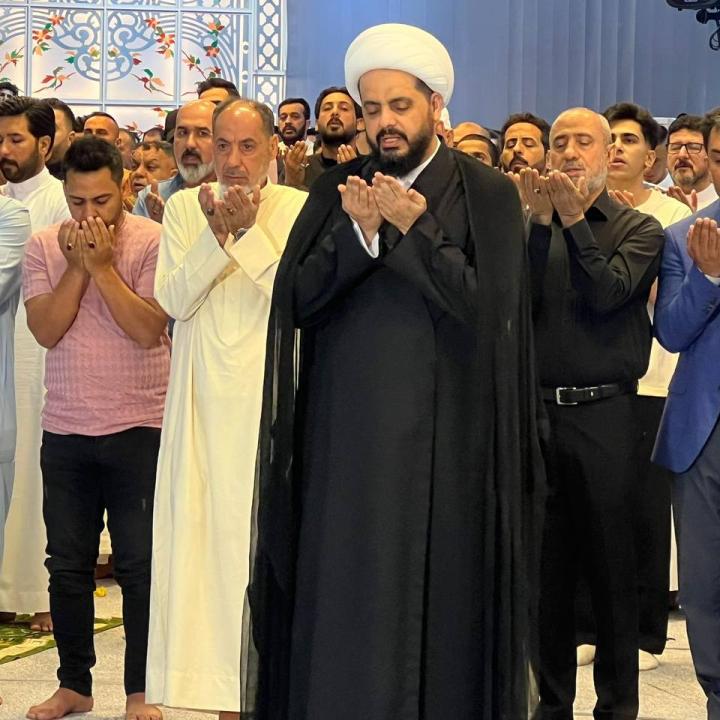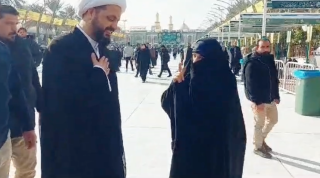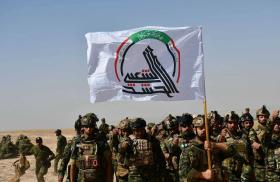
How Long Will Qais al-Khazali Hide in Iran?

The leader of Asaib Ahl al-Haq has been abroad for weeks, and his movements (and those of his deputies back home) are worth watching closely.
Over the past few weeks, Qais al-Khazali—the leader of the Iran-backed Iraqi militia Asaib Ahl al-Haq (AAH) and a U.S.-designated terrorist and human rights abuser—has been out of the picture, prompting public rumors that he was killed or injured in a drone strike. To deny these rumors, the head of AAH's office in Tehran, Ghadir Sharif, told reporters on December 21 that “Khazali has been in the Islamic Republic of Iran for some time and settled for a period in the city of Mashhad in northeastern Iran, where the shrine of Imam Ali bin Musa al-Rida is located. After that, he moved to the city of Qom in central Iran to continue his individualized hawza [seminary] studies.”
Khazali frequently visits Mashhad and Qom, which Shia Muslims regard as holy cities, so there is nothing peculiar about that. Yet Sharif's claim that Khazali is in Iran for religious studies is unusual for two reasons. First, despite his frequent visits, this is likely the first time his presence has been described as related to religious studies. Second, Khazali has worked hard in recent years to portray himself as an active, hands-on militia and political leader. For him to suddenly shift focus to hawza studies is quite unexpected.
Qais Leaves Just When He Is Needed Most
Given the significant influence AAH holds within the Iraqi government, one would assume that Khazali is an exceptionally busy individual. Indeed, he is normally seen holding frequent meetings with Iraqi and international actors, delivering speeches, and making numerous TV appearances. Yet this pattern changed in recent months amid the broadening regional conflict that began on October 7, 2023—especially once Iran's so-called "axis of resistance" suffered major setbacks in late 2024. The fact that Khazali appears to be reducing his presence in the Iraqi political sphere at a time when parties are beginning to prepare for the October 2025 general elections makes this move even more intriguing.
Notably, on December 23, AAH-affiliated social media accounts shared footage of Khazali visiting the Iraqi city of Karbala, seemingly aimed at refuting rumors of his death (Figure 1). Although this indicates he returned to Iraq recently, it does not mean that he remained there, nor that his long stay in Iran will be ending anytime soon. In all likelihood, he became fearful of an Israeli or American strike and has sought refuge in Iran indefinitely.
Looking Ahead
Khazali’s move is reminiscent of Muqtada al-Sadr's 2008 decision to relocate to Iran for “religious studies.” In that case (and again in 2012), Iranian officials warned Sadr that he might be targeted (in 2008 by the United States; in 2012 by AAH, ironically). After Tehran offered him sanctuary, Sadr announced his withdrawal from politics, though he returned home on multiple occasions and played critical roles in the 2018 and 2021 elections. Tellingly, Sadr's "studies" in Iran were never long enough to increase his clerical rank.
In Militia Spotlight's assessment, Khazali is similarly unlikely to step down from politics completely or reduce his activities permanently. Yet his absence and subsequent media statements by AAH officials point to unusual and intriguing developments within the world of Iraqi muqawama (resistance) militias. Something is up, and the next acts in this developing drama bear close watching. In Khazali's absence, his brother Laith (also a U.S.-designated terrorist and human rights abuser) will be the main power broker within AAH, alongside (and probably in rivalry with) longtime deputy leader Muhammad al-Tabatabai. Monitoring how these two interact will be especially worthwhile.





